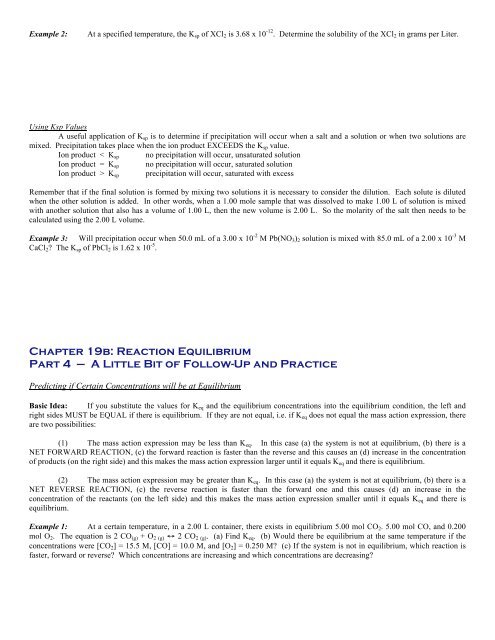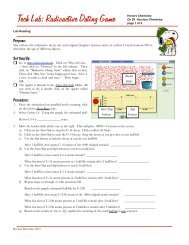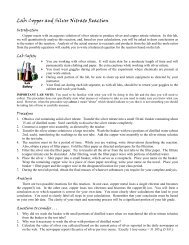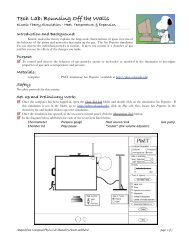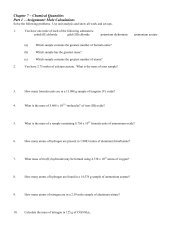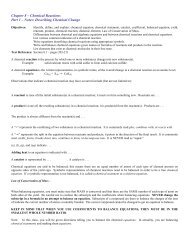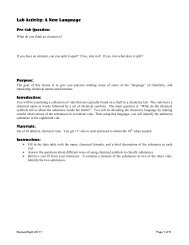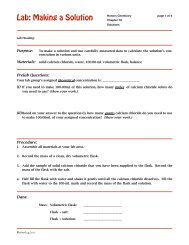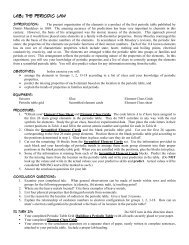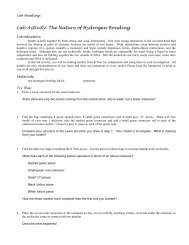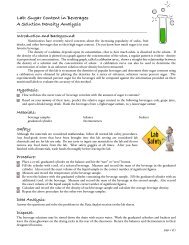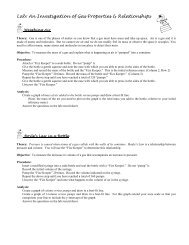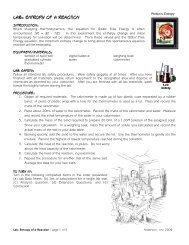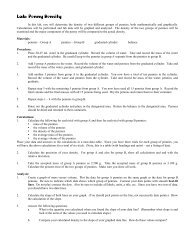Chapter 19B Notes - Honors Chemistry Coursework
Chapter 19B Notes - Honors Chemistry Coursework
Chapter 19B Notes - Honors Chemistry Coursework
You also want an ePaper? Increase the reach of your titles
YUMPU automatically turns print PDFs into web optimized ePapers that Google loves.
Example 2:<br />
At a specified temperature, the K sp of XCl 2 is 3.68 x 10 -12 . Determine the solubility of the XCl 2 in grams per Liter.<br />
Using Ksp Values<br />
A useful application of K sp is to determine if precipitation will occur when a salt and a solution or when two solutions are<br />
mixed. Precipitation takes place when the ion product EXCEEDS the K sp value.<br />
Ion product < K sp no precipitation will occur, unsaturated solution<br />
Ion product = K sp no precipitation will occur, saturated solution<br />
Ion product > K sp precipitation will occur, saturated with excess<br />
Remember that if the final solution is formed by mixing two solutions it is necessary to consider the dilution. Each solute is diluted<br />
when the other solution is added. In other words, when a 1.00 mole sample that was dissolved to make 1.00 L of solution is mixed<br />
with another solution that also has a volume of 1.00 L, then the new volume is 2.00 L. So the molarity of the salt then needs to be<br />
calculated using the 2.00 L volume.<br />
Example 3: Will precipitation occur when 50.0 mL of a 3.00 x 10 -2 M Pb(NO 3 ) 2 solution is mixed with 85.0 mL of a 2.00 x 10 -3 M<br />
CaCl 2 ? The K sp of PbCl 2 is 1.62 x 10 -5 .<br />
<strong>Chapter</strong> 19b: Reaction Equilibrium<br />
Part 4 – A Little Bit of Follow-Up and Practice<br />
Predicting if Certain Concentrations will be at Equilibrium<br />
Basic Idea: If you substitute the values for K eq and the equilibrium concentrations into the equilibrium condition, the left and<br />
right sides MUST be EQUAL if there is equilibrium. If they are not equal, i.e. if K eq does not equal the mass action expression, there<br />
are two possibilities:<br />
(1) The mass action expression may be less than K eq . In this case (a) the system is not at equilibrium, (b) there is a<br />
NET FORWARD REACTION, (c) the forward reaction is faster than the reverse and this causes an (d) increase in the concentration<br />
of products (on the right side) and this makes the mass action expression larger until it equals K eq and there is equilibrium.<br />
(2) The mass action expression may be greater than K eq . In this case (a) the system is not at equilibrium, (b) there is a<br />
NET REVERSE REACTION, (c) the reverse reaction is faster than the forward one and this causes (d) an increase in the<br />
concentration of the reactants (on the left side) and this makes the mass action expression smaller until it equals K eq and there is<br />
equilibrium.<br />
Example 1: At a certain temperature, in a 2.00 L container, there exists in equilibrium 5.00 mol CO 2 . 5.00 mol CO, and 0.200<br />
mol O 2 . The equation is 2 CO (g) + O 2 (g) 2 CO 2 (g) . (a) Find K eq . (b) Would there be equilibrium at the same temperature if the<br />
concentrations were [CO 2 ] = 15.5 M, [CO] = 10.0 M, and [O 2 ] = 0.250 M? (c) If the system is not in equilibrium, which reaction is<br />
faster, forward or reverse? Which concentrations are increasing and which concentrations are decreasing?


